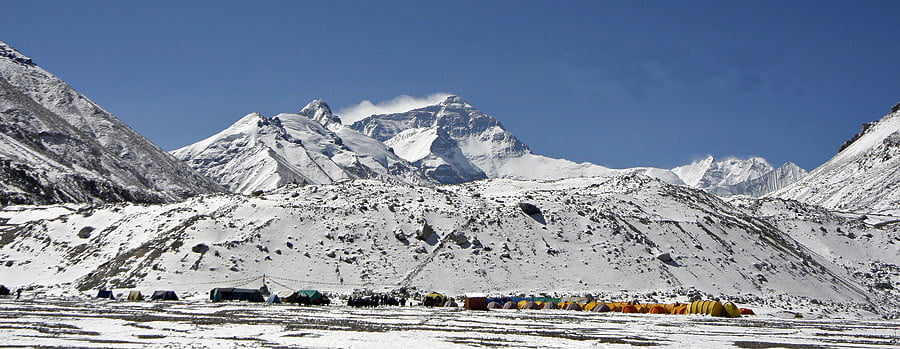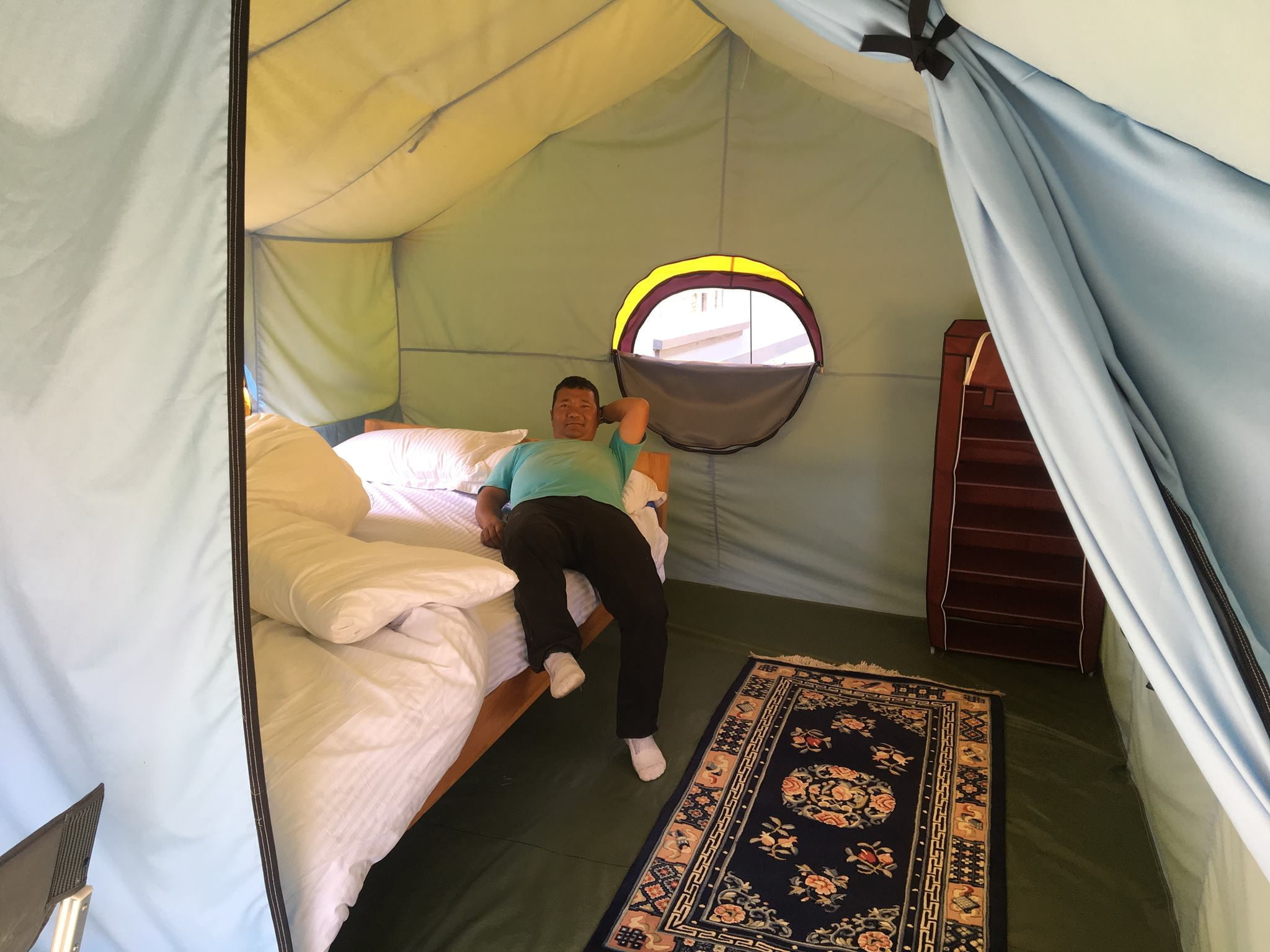
Natasha Poletaeva
44 years, Russia
10 Shame Questions about Mt Everest
Even if you are an experienced alpinist, you cannot learn all the tips for climbing Everest beforehand.
Read the answers to the “Shame Questions” that glossy guidebooks just don’t address. And for sure we cannot leave the “Garbage on Everest” problem without our attention. The situation is not as simple as it is presented by different media…

Thanks for the idea & questions to the member of Mountain Planet Alpine Community Robert Mojsov.

Mountain Planet interviewed two ascenders: Ludmila Korobeshko (3-times Everest climber) and Sergey Kofanov (2-times Everest climber, Everest rescued ops participant; founder of the Mountainplanet.com).
1. Is it true that you don’t bathe at Everest?
Ludmila Korobeshko
It may come as a surprise but, yes, I must say that the less you wash during the ascent – the better. This way, you minimize the risk of catching a cold, and catching a cold is the last thing you want before climbing. It’s better to climb “dirty”, but then again, you can always use wet wipes. Then there is “shampoo powder” – some people like it, some don’t; it’s a matter of personal preferences, really.
As a rule, the bath in the Base Camp is essentially a large tent with a few barrels of cold and hot water. You heat the water on a gas stove (the gas is from the gas cylinders that the expedition brings along).
Sergey Kofanov
During our trekking trips in the Himalayas, a lot of us got used to using wet wipes. However, when it comes to climbing real heights, it’s not that simple – at night, the temperature drops well below the freezing point, and all of your wet wipes will turn into a chunk of ice, defrosting which would be no next to impossible. And, as we all know, sometimes (and quite often, in fact) time is a factor. To avoid an epic fail, make sure to keep your wet wipes in your sleeping bag at night.

Photo: Harry Kikstra, 7summits.com
Generally, you must think beforehand when taking a shower in the Everest Base Camp – because there’s nothing as easy as catching a cold there, and it might take you weeks to recover. So, it’s up to you to decide whether to take a shower and jeopardize the success of the whole expedition or to walk around “dirty” but healthy. As for me, every time after I take a shower I go to my tent, crawl into the sleeping bag and lie there for about an hour until my body comes to equilibrium again.
2. How does an Everest toilet work?
Ludmila Korobeshko
A toilet is essentially a special tent in each expedition. If there is a certain percentage of ladies in the crew, there may be two tents – men’s and women’s.
This is, of course, not just a “hole in the ground” – the staff dig a pit and you put special barrels down there, which are later removed by the sewage service.
Higher up, they may also put up a tent, but, of course, you don’t use any barrels up there – you just stretch the tent over a split in a rock. But in the two topmost camps you solve the toilet problem just by stepping “behind a rock”: on a steep slope you can’t do it any other way.
Everest is indeed very cold, and, if you have a chance, you try to choose the warmer time of the day to do that business.

Photo: 7summitsclub.com
And for the higher altitudes, as well as for the time before the ascent, we have this lifehack. You need to take Imodium or some other diarrhea medicine to make sure you don’t get the runs at the wrong moment. Because just imagine a situation when you are up high, wrapped up in an insulated down one-piece, buckled up in a harness, and you suddenly need to go… It makes me shudder even to imagine such a situation, although once I did witness something of the sort: that person had to change several times. And in such a situation, it is not only your fingers that are in the danger of freezing.
Sergey Kofanov
Is it cold going to the toilet up there? If you don’t have the runs which make you jump out of the tent every half-hour, regardless of what kind of weather is outside, it shouldn’t be much of a problem because there is always a possibility to catch a moment when there is no wind and it’s not so freezing. But if you need to go at night, and it’s -50°С, then, of course, you’re freezing.
As a rule, at altitudes higher than 7000 meters you don’t step away from your tent any farther than just a few steps. Anticipating your question: is it dirty all around up there? For example, in the 8300-meter camp, before summit push, there are from 30 to 50 people. Out of them, only about 10 percent go to the toilet (the rest prefer to endure it). Second, at high altitudes strong winds blow that sweep the snow, and literally the next day you are not going to see any “traces of vital activities”.
3. Can I wash my things at Everest?
Ludmila Korobeshko
The service is gradually improving. Back in the 2000’s, we would do little laundry at the ABC. We had a “bath” tend with small tubs, in which you could wash your things if you really wanted to. Then these Tibetan “kitchen boys” came about; you could give your laundry to them – just like in a hotel – and for a certain price they would wash it in the “river” (the Everest Base Camps are situated on a glacial drift, from where water flows, forming glacial lakes).
These are also the sources of the flowing water for the camp’s kitchen. As for the electricity, each expedition needs to bring along its own power generator.

Photo: 7summitsclub.com
Sergey Kofanov
You can either do your laundry yourself in the Base Camp or hand your stuff over to the local Tibetan guys who will do the same work for small tips. Higher up than the Base Camp nobody will do it for you, even for money. Oh, by the way, a small lifehack: make sure to buy some clothes pegs on your way to the Base Camp, or else the wind will blow your drying laundry all over the place, and you will be apologetically explaining to some foreign climber how your underpants got into his or her sleeping bag…
4. How do they feed you in the expedition?
Ludmila Korobeshko
The Base Camp catering service has made a great progress. For one, in 2003-2005 virtually every climber would lose about 15 kilos in the course of the ascent. Back in those days, the catering service was provided by local companies who mostly offered rice and “dalbat” (a kind of rice with gravy or lentil soup). Occasionally, they would serve yak meat, which was pretty difficult to chew.
Today, the climbers don’t lose their weight, and the Nepalese chefs who work with expeditions on a permanent basis are even sent over to Europe to improve their cooking skills. Now in the camps they offer soups, cutlets, and salads. There is even a “buffet” system of heated trays and an excellent choice of dishes, meat and dairy products, fruits and vegetables.

Photo: 7summitsclub.com
Sergey Kofanov
What do mountain climbers eat in the high-altitude camps? Well, you cannot bring apples or cucumbers with you to the altitude – they will simple freeze up there. Essentially, they use sublimates like instant cereals or pot noodles – everything that you can pour with boiling water. Today, the selection of sublimates is extremely large; they make such products specifically for outdoor activities.
In a regular commercial tour, the food, cutlery, burners, and such like, is raised to the high-altitude camps by Sherpas – you don’t have to be carrying either your mug or spoon to the peak. A 30-liter climbing backpack will do the trick. It’s got enough room for two oxygen bottles and some extra warm things to wear.
5. Have there been any cases of theft in the Base Camp?
Ludmila Korobeshko
Very few and far between. True, somebody may pinch your oxygen bottle, and not in the Base Camp but still higher up, when no one is watching. In the daytime, there is always somebody in the camp: if the climbers go up to the summit, or just on an acclimatization trip, a large expedition will always include a caretaker or a chef who stay down, plus the kitchen boy. They take the responsibility of looking after the camp.

Photo: 7summitsclub.com
Sergey Kofanov
I frankly cannot recall any cases of theft at Everest – the Base Camp is essentially a restricted area, and you need a permit to get to it. On the other hand, nobody’s checking the permits at night, and anyone can get in. But specifically for this, large-scale expeditions have a safe with them, in which they lock the valuables like passports, money, and such like, during the ascent or acclimatization trips. So, draw your own conclusions!
6. Do they ever fight at Everest?
Sergey Kofanov
Probably, the most notorious incident is the story about the brawl that happened on Everest involving Simone Moro, Ueli Steckn, and the Sherpas in 2013 on the Nepalese side, which ended in termination of the ascent. And if we are to speak about a regular fight, like somebody quarreled with somebody and they had a square-go, well, you cannot entirely rule out such a possibility but this rarely goes public.
7. Do you need money in the Base Camp?
Ludmila Korobeshko
Up to the altitude of 5200 meters, the Base Camp can be accessed from the Chinese side by a great roadway (it’s called “Friendship Highway”). The Base Camp of Everest is a large field about three by three kilometers in size where all the expeditions make their camps. During the season, the locals put up tents on the edge of the field – something like a little bazar. Chiefly, they sell souvenirs, of course, but you can also buy some water, have a snack or a cup of tea. This all is situated before the barrier after which the camp itself starts. Trekking expeditions also come to that spot but they cannot get inside the camp territory – you need a special permit for that. This is all controlled by the liaison officer who checks the expeditions for mandatory permits.
Basically, in the Base Camp, you can do without any money, unless you want to spend some of your cash on souvenirs or pay for the laundry services. In the Camp on the Northern side, they sell for Yuan because it’s Chinese territory. They also accept US dollars.
8. How do they sleep in the Base Camp?
Ludmila Korobeshko
Of course, you will be very uncomfortable and chill sleeping on one ground pad and a sleeping bag for a month and a half. Little by little, they started hoisting up high some mattresses, pillows and blankets that you can by on the way to Everest. After the expedition, the climbers give some of these things away to the locals, some expedition organizers keep it for the next season, and somebody may even take his blanket as a souvenir!

It's not a health camp, it's new tents in Everest Base Camp! Photo: 7summitsclub.com
Sergey Kofanov
How many sleeping bags do you need in the Base Camp? One is usually enough but two are more convenient. You can leave one in the ABC, and hoist the other one up, thus sparing yourself the bother of carrying your sleeping bag around for every acclimatization trip. Ground mats are not a must these days – you can buy folding beds, pillows, blankets, and even bedsheets: all of these can be bought in Katmandu or Lhasa in a supermarket and then delivered to the camp either by trucks or by yaks.
9. What is the situation with the trash left by the expeditions?
Ludmila Korobeshko
The Sherpas of each expedition come to the Base Camp well in advance (10 days before the actual start in order to put up the camps – the base and the high-altitude ones), and after the climbers depart, the service personnel stay to clean up. The Sherpas particularly like the abandoned oxygen bottles: for a Tibetan, this means extra source of revenue (up to 50 dollars), for them, it’s a lot of money.

Photo: Harry Kikstra, 7summits.com
True, there are situations when you cannot carry everything out of the altitude camps: Everest is very windy at times. Once there was a time when the Sherpas could not get to the higher camp at all because of the wind; they had to abandon everything there, and the storm tore the tents to pieces. But this is rather an exception than a rule.
Sergey Kofanov
Gloating on these “garbage” issues, the journalists are rather stuck in the past. On the Tibetan side, garbage trucks regularly come to the camp and carry away all the waste. On the Nepalese side, they hoist the garbage bags down on yaks. Years ago, when the traffic of mountain climbers was smaller, there was no good road, and the expeditions were cheaper, the issue of waste disposal wasn’t given so much attention.
But it is worthwhile to know that today, in addition to the climb permit, the leader of each expedition also makes a 4000 dollars Garbage Deposit in cash. If the expedition has left no garbage on the mountain, the Liaison Officer returns the deposit to its leader upon its completion. But then again, you can’t really effectively check whether the climbers left any trash in the altitude camps, so the question of recovering the deposit is ultimately a matter of the head’s conscience and his further reputation. In any case, it’s a very close-knit community, pretty much everybody knows everybody, and if you are careless about what you leave behind, they may revoke your permit for the next expeditions.
10. Do they have love affairs in the Base Camp?
Ludmila Korobeshko
It all depends on the people! But this is rather an exception because everybody is concentrated on climbing, and everybody has specific tasks to do. Many people even become teetotalers for the time of the expedition, although, yes, there is alcohol in the camp. Well, and there aren’t that many ladies on Everest.

Public spase in Everest Base Camp (Tibetan side). Photo: 7summitsclub.com
Sergey Kofanov
They sure do! And I personally know a family couple who met at the Everest Base Camp in 2006, and they are still together. On the other hand, Sherpas and Tibetans consider as unacceptable any sexual manifestations during the ascent of Everest because they claim that these are an act of terrible disrespect for the mountain, which can bring bad luck not only to the “perpetrators” of the crime but also to all the other members of the expedition.






